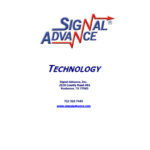Industrial Examples
Signal Advance, Inc. has identified whole classes of physical analog signal sensors that operate within an optimal frequency range for signal detection temporal advancement, along with a host of probable licensing targets. There are potentially hundreds of potential applications of Signal Advance Technology involving a broad range of sensors which detect physical parameters. Potential industrial applications/markets include a wide range of commercial, industrial, military and transportation areas such as
1) process control
2) alarm/detection systems
3) vehicular/flight control
4) chemical processing systems
5) manufacturing/production
6) military targeting/weaponry
7) cybersecurity
The Company has identified whole classes of physical analog signal sensors that operate within an optimal frequency range for signal detection temporal advancement, along with a host of probable licensing targets. There are potentially hundred of potential applications of SA technology involving a broad range of sensors which detect physical parameters. Industrial applications/markets include a wide range of commercial, industrial, military and transportation areas such as, 1) industrial process control, 2) alarm/detection systems, 3) flight/ vehicular control, 4) chemical processing systems, 5) manufacturing/ production, and 6) military targeting/weaponry.
In industrial process control, physical parameters such as temperature, pressure, flow, etc. provide input data for closed-loop control systems that act to optimize production yields. In the petrochemical industry (e.g. distillation), transient response times are measured in seconds/ minutes making these processes good candidates for the use of SAT.
In refining, for example in distillation, faster closed loop response provides better disturbance rejection. In many refining processes, response times are relatively slow, making these processes good candidates for the application of SA technology. Improvements in product yields and energy savings as well as safety could translate into millions of dollars in economic benefit.
Compressors run most efficiently when operating near their stability limits (or stall margins). Compressor control systems rely on real-time pressure, temperature and flow measurement to determine the operating point and surge margin. Delay in detection of these signals and response delays negatively affect performance. Reducing or eliminating these delays can significantly reduce the probability of compressor stalls and/or surges occurring, thereby enhancing operational stability margins and increasing productivity, as well as safety.
In high performance aircraft engine control systems, real-time detection of inlet airflow distortion is used for high-speed engine control in order to increase engine stability, reduce stall-margins, increase overall performance and lower fuel consumption.
In transportation, SA technology could improve crash avoidance, safety/security, drive-train performance and overall vehicular control. For example, in engine combustion control delays affect performance, fuel efficiency and exhaust pollutants. SA applied in combustion control could improve fuel efficiency and engine performance as well as reduce emissions.
With gas-turbine engines, improved flow-control includes faster closed-loop fuel flow control, compressor operation closer to its stall boundary, fuel/air mixing control and air cooling based on turbine temperature – all areas in which SA technology could significantly reduce system response times and improve performance.
In defense systems, feedback delays reduce response effectiveness. For example, in targeting systems, faster detection of changes in target velocity and trajectory and improved response time could enhance target acquisition and tracking accuracy.
In cybersecurity, using analog encryption (vs. digital), the ability to temporally shift analog signals (representing data) derived from the integration of multiple methodologies will make remote hacking virtually impossible – mitigating cybersecurity risk and improving infrastructure reliability and protection.
This discussion has provided just a few examples of industrial applications that may benefit significantly from use of SA technology. The improvements would most likely be in operating efficiencies (cost reductions), performance/yield and accident prevention/reduction.
To inquire more about how Signal Advance Technology could benefit your industry or to discuss licensing and development options, please contact us. Read more on the Market Analysis for Industrial Applications of SAT.
To download or view the complete Signal Advance Technology Document please visit the Validations page of our website or

